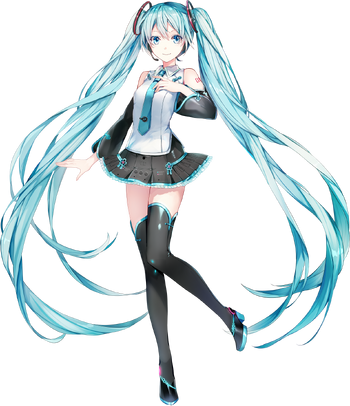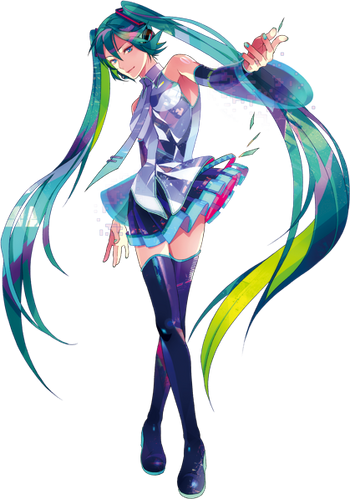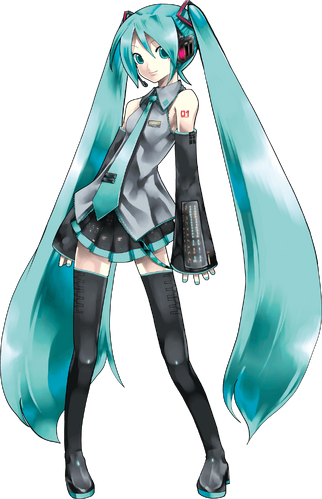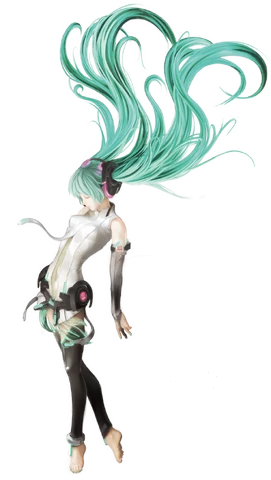Hatsune Miku
- “Miku” redirects here. For other uses, see Miku (disambiguation).
Hatsune Miku
-
V4
-
V3
-
V2
-
V4X Standard
-
Chinese


-
English
-
V3 Standard


-
V2 Standard
-
Append


General information
Sex
Female
Age
16
Height
158cm
Weight
42kg
Voice
Saki Fujita
Product information
-
V4
-
V3
-
V2
Company
Crypton Future Media, Inc.
Release
- August 31, 2016 :: V4X Standard
- September 5, 2017 :: V4 Chinese
Language
Multilingual; Japanese, English, & Chinese (Mandarin)
Illustrator
- iXima :: V4X Standard
- Mamenomoto :: V4 Chinese
Type
Character Vocal Series, VOCALOID4, Mobile VOCALOID Editor, Piapro Studio
Code
CV01
Affiliation
- YAMAHA Corporation
- SEGA
- Piapro Studio
Company
Crypton Future Media, Inc.
Release
- August 31, 2013 :: V3 English
- September 26, 2013 :: V3 Standard
- October 9, 2014 :: Light & Vivid
Language
Multilingual; English & Japanese
Illustrator
- Zain :: V3 English
- iXima :: V3 Standard
Type
Character Vocal Series, VOCALOID3, VOCALOID NEO, Piapro Studio
Code
CV01
Affiliation
- YAMAHA Corporation
- SEGA
- Piapro Studio
Company
Crypton Future Media, Inc.
Release
- August 31, 2007 :: V2 Standard
- April 30, 2010 :: Append
- April 3, 2014 :: eV2
Language
Japanese
Illustrator
- KEI :: V2 Standard
- Masaki Asai :: V2 Append
Type
Character Vocal Series, VOCALOID2, eVocaloid
Code
CV01
Affiliation
- YAMAHA Corporation
- SEGA
- Piapro
Image Gallery
Category Gallery
Hatsune Miku (初音ミク), codenamed CV01, was the first Japanese VOCALOID to be both developed and distributed by Crypton Future Media, Inc.. She was initially released in August 2007 for the VOCALOID2 engine and was the first member of the Character Vocal Series. She was the seventh VOCALOID overall, as well as the second VOCALOID2 vocal released to be released for the engine. Her voice is provided by the Japanese voice actress Saki Fujita (藤田咲, Fujita Saki).[1][2]
There have since been numerous installments, such as additional voice libraries dubbed ‘Append’, as well as an upgrade for the VOCALOID3 engine, which contained an English vocal release. She received a VOCALOID4 update to her Japanese and English voicebanks in August 2016, as well as a Mandarin Chinese voicebank in September 2017.
On August 31, 2019, Miku received her first voicebank outside of VOCALOID, that being Piapro Studio with her NT release. While Crypton is focusing on their own program, they are still in collaboration with YAMAHA and will continue to sell VOCALOID products in parallel to the Piapro Studio editions.[3][4][5]
Concept
Crypton had the idea to release Miku as “an android diva in the near-future world where songs are lost.”[6][7]
Etymology
The name was chosen by combining hatsu (初, “first”), ne (音, “sound”), and Miku (未来, a personal name that shares its spelling with the word for “future”). It thus means “the first sound from the future.” Her name was based on her concept of that when a sound is first spoken.[8]
Her codename of “CV01” means “Character Voice 01”.
Her name in Chinese is “Chūyīn Wèilái” (Simplified Chinese: 初音未来; Traditional Chinese: 初音未來).
Appearance
When KEI illustrated Miku, he was given a color scheme to work with (based on the YAMAHA synthesizers’ signature blue-green colour) and was asked to draw Miku as an android. Crypton also provided KEI with Miku’s detailed concepts, however, Crypton said it was not easy to explain what a “Vocaloid” was to him. KEI said he could not create an image of a “singing computer” at first, as he did not even know what a “synthesizer” was. It took him more than a month to complete the commission.[9]
Miku was originally intended to have a different hairstyle, but after trying out pigtails, KEI thought they were more suitable. Her pigtails have since become an iconic part of her design. On June 22, 2012, Hatsune Miku’s twin tails even earned her the title of the Twin Tail which best represented the 2000s, marking her the best set of Twin Tails from the dawn of the 21st century. She now shares her twin tail distinction with other characters like Sailor Moon (who won best Twin Tails back in the 90s period).[10]
The digital design on Miku’s skirt and boots are based on synthesizer program colours, and the bars represent actual bars within the program, following Crypton’s ideas. Part of her design is based on some of YAMAHA’s keyboard models, particularly the DX-100 and the DX-7.[11][12] The thin squares around her pigtails are futuristic ribbons made of a special material that floats in place. As seen in KEI’s art for Miku, they are able to hold Miku’s pigtails in place without having to physically touch the hair itself. The ribbons are also reported by KEI to be the hardest item on the character’s design for cosplayers to recreate.
After an internet meme involving Hachune Miku, Miku was associated with a spring onion (often mistaken for a leek due to the similar appearance). This, along with KAITO’s association with ice cream, started a discussion called “the Item War” within the VOCALOID fandom, where it became traditional for new VOCALOIDs to have an item assigned to them and the items were debated upon until one stuck via an Internet Meme. This occurrence has since died out.
Her VOCALOID2 Append design is often subjected to censorship. In the original design, there is a bare strip of flesh under the tie area. In many depictions, this bare strip of flesh is not shown and is covered. For example, while Max Factory models showing the uncensored version in their normal and Figma models, the Project Diva game series shy away from showing any exposure.
Relations
For more on VOCALOID relationships, see the FAQ.
History
Marketing
Miku’s initial marketing was similar to past software synthesizers and VOCALOID voicebanks, and was standard marketing for the software at her time of release. For the most part a large proportion was centered on DTM MAGAZINE, like MEIKO and KAITO before her since the readership of the magazine had greatly influenced those two past VOCALOIDs. The only pre-planned promotion was with DTM MAGAZINES November 2007 issue – due to the inclusion of a CD with the demo of Miku on it, this particular issue sold out. When Hatsune Miku was on pre-order it was noted MEIKO and KAITO had no prospect of receiving updates and that Miku would be taking over their roles going forward.[13]
She was originally aimed only at professional producers; the amateur and Otaku market hadn’t fully formed yet, and so it was not initially considered.[14][15] For a variety of reasons, Miku received unexpected commercial success. Due to Miku’s popularity boom, Crypton had the chance to take advantage of early technical support for Miku and several guidebooks and magazine support were released solely focused on her vocals. This type of technical coverage was even possible long after Miku’s initial release and methods of adapting her vocals are the most well documented among the VOCALOID2 era vocals.
Since the success of her voicebank led to an expansion of marketing possibilities, most of the mass marketing has come after her initial release as a response to her popularity. Even with the addition of other Character Vocals, Miku’s name continues to be used as the primary source of marketing for Crypton Future Media. In March 2012, the Nomura Research Institute estimated that the sales of all “Hatsune Miku” brand goods added up into the region of ¥10,000,000,000 since her release in 2007.[16] Miku’s name is now the easiest of all VOCALOIDs to market. Also owed to her popularity, many VOCALOID related products such as piano sheet music packs, books, and magazines carry her image on the front cover. Around January 28, 2013, a 3 day survey was run by Tokyo Polytechnic University. During the survey (based on ages 12–38) 95% of those entering reported knowing who Hatsune Miku was, in comparison participants barely knew who Megpoid, IA, or Aoki Lapis were.[17]
Corolla Miku, presented in 2011, wears slightly different attire compared to KEI’s original design: instead of one skirt stripe and single floating ribbons, she now has two, as was intended by the client.
In 2011, Crypton began to focus on marketing Miku to U.S. audiences. On May 7, USAmazon placed a preview of Supercell’s hit song, “World is Mine”, as a single. When the song finally went on sale, it came 7th in the top 10 World singles list on iTunes in its first week of sales.[18] The entry was presented as “The World is Mine Feat. Hatsune Miku”. Crypton had to consider who they were aiming the advertisements of Miku at (mostly the web fanbase) and had to check the differences between the Japanese and English fan communities. Since Crypton had always sold Miku as a virtual instrument in Japan, they asked their Japanese fan base if it was acceptable for them to sell her as a virtual singer to the new market audience.[19] The main purpose of the Miku English version is to allow Japanese producers to break into the West and also expand their audiences.[20]
Crypton Future Media do not approve of using Miku in politics. This is, so far, one of the biggest areas of marketing that Miku has avoided being used for.[21] However, Hatsune Miku sang the theme song for Japanese National Election candidate, Yoshikazu Tarui. Despite this, her mascot was not used; instead, a pink twin-tailed girl dubbed Android Rui replaced her.[22]
Crypton Future Media also applied for trademark on the 26th of June 2012.[23]
When the tsunami hit Japan in 2011, Miku was chosen as a character who would help represent Japan. This was because of how common her image was appearing with many younger people knowing who she was. She was already in music based textbooks and her influence on music was heavily known by the Minister for Education for Japan.[24]
The fact that products with Miku can sell out quickly makes her attractive to even slow growing industries. Products with Miku on them can even sell out in public events within 30 minutes of events opening to the public. This helps fuel marketing in even handcrafted trades, as fans are attracted to these “one of a kind” products.[25]
Starting on March 15, 2021, Crypton Future Media announced a collaboration with the “Hatsune Miku Chronicle” (初音ミク・クロニクル) art exhibition event titled “Hatsune Miku Chronicle × piapro “What If You Draw? “Hatsune Miku” Software Package Illustration Recruitment!” (もしもあなたが描いたら?「初音ミク」ソフトウェア パッケージイラスト募集!), a special recruitment for users to draw their own original character named “Hatsune Miku” while keeping the basic profile, image and color settings used for Hatsune Miku’s initial artwork in 2007 with the winning illustration being made into a special software package based on the submitted work.[26] The award-winning works would be exhibited at the art exhibition “Hatsune Miku Chronicle” scheduled to be held in 2021. [27][28][29] Over the course of four months users were able to submit artwork to Piapro using the “#クロニクル_ミクif” tag.[30] Coinciding with the recruitment, Good Smile Company announced a new Nendoroid figurine based on Hatsune Miku’s original concept design now known as Hatsune Miku if Ver. (初音ミク if Ver.).[31] A finalized illustration of the original design by KEI was also announced.[32] On June 29, the contest concluded and three finalists were selected.[33][34] Three awards were given: the “Best Award” was awarded to 千代[35], the “KEI Award” was awarded to 梨伊荼[36] AND the “Saki Fujita Award” was awarded to ろきの.[37] Pre-release images of the Hatsune Miku if Ver. Nendoroid were revealed on July 14th and the illustration by KEI was revealed as well as the announcement of Kagamine Rin & Len if and Megurine Luka if proposals.[38][39] The Nendoroid was placed up for pre-order starting July 15th on the official Good Smile Company store and more pre-release photos were added.[40][41]
Voicebanks
The following covers the VOCALOID software, for future releases see Piapro Studio releases.
- Hatsune Miku – Original
- Designed to be a cute, high pitched and young female Japanese singer, the vocal is of a non-professional vocalist and represents a voice-acted result. It has strong attack and is known for its fairly high adaptability and morphing ability. Due to its high usages among Japanese producers, the vocal was regarded as both “The VOCALOID” voicebank, as well as the “standard” vocal among VOCALOID usage, the vocal itself was meant to replace KAITO and MEIKO from VOCALOID. Miku was created to have standout vocal traits compared to MEIKO. This was also the first vocal for VOCALOID2 that was designed for VOCALOID2 itself.
- Misc. versions
- Her vocal was adapted to the eVocaloid chip and sold with the Pocket Miku piano.
- Her vocal was also available, though restricted in “Let’s sing with Miku ♪“. The version of the voice is unknown. The voicebank itself was accessed via the NetVOCALOID database and was one of the few VOCALOIDs who allowed users to access the network.
- Hatsune Miku – Sweet
- Designed to be a sweeter sounding version of the “Original” vocal, this vocal is a voice acted result and designed to act very different from the “Original” vocal. The tone is cuter than the original and designed to make Miku sound smaller and is meant for more expressive songs.
- Hatsune Miku Append (VOCALOID2), April 30, 2010
- Hatsune Miku V3 (VOCALOID3), September 26, 2013
- Hatsune Miku V3 (VOCALOID3, VOCALOID NEO, Piapro Studio), September 26, 2013
- Hatsune Miku V4X (VOCALOID4, Piapro Studio2), August 31, 2016
- Hatsune Miku – Dark
- Designed to be a darker tone version of the “Original” vocal, this vocal is a voice acted result and designed to act very different from the “Original” vocal. This vocal is designed to make Miku sound moodier and is meant for more expressive songs.
- Hatsune Miku Append (VOCALOID2), April 30, 2010
- Hatsune Miku V3 (VOCALOID3, VOCALOID NEO, Piapro Studio), September 26, 2013
- Hatsune Miku V4X (VOCALOID4, Piapro Studio2), August 31, 2016
- Hatsune Miku – Soft
- Designed to be a softer tone version of the “Original” vocal, this vocal is a voice acted result and designed to act very differently from the “Original” vocal. This vocal is designed to make Miku sound gentle and is meant for more expressive songs.
- Hatsune Miku Append (VOCALOID2), April 30, 2010
- Hatsune Miku V3 (VOCALOID3, VOCALOID NEO, Piapro Studio), September 26, 2013
- Hatsune Miku V4X (VOCALOID4, Piapro Studio2), August 31, 2016
- Hatsune Miku – Light
- Light is a higher pitched vocal with a different tone to “original”. Designed to be more operatic and angelic than the “Original” vocal with a light but the bold style of voice-acted vocal.
- Hatsune Miku Append (VOCALOID2), April 30, 2010
- Hatsune Miku V3 Light (VOCALOID3, Piapro Studio), September 26, 2013
- Hatsune Miku – Vivid
- VIVID is a high but strong pitched vocal with a different tone to “original”, being lower in pitch than “Light”. Designed to be more strong and powerful voice acted vocal.
- Hatsune Miku Append (VOCALOID2), April 30, 2010
- Hatsune Miku V3 Vivid (VOCALOID3, Piapro Studio), September 26, 2013
- Hatsune Miku – Solid
- Solid is a voicebank similar to “Original”, but with firmer sounds and louder results and is designed for clarity.
- Hatsune Miku Append (VOCALOID2), April 30, 2010
- Hatsune Miku V3 (VOCALOID3, VOCALOID NEO, Piapro Studio), September 26, 2013
- Hatsune Miku V4X (VOCALOID4, Piapro Studio2), August 31, 2016
- Hatsune Miku – English
- The English version of the Hatsune Miku vocal was also planned for Miku’s original V2 vocal, though that project became Megurine Luka instead. Despite the fact this is the English version, it does not always match the tone of the “Original” voicebank. Results have varied per release due to improvements between versions with consequential versions being very different in tone and pronunciation.
- Hatsune Miku English (VOCALOID2), Unreleased
- Hatsune Miku V3 English (VOCALOID3, VOCALOID NEO, Piapro Studio), August 31, 2013
- Hatsune Miku V4 English (VOCALOID4, Piapro Studio2), August 31, 2016
- Hatsune Miku – Chinese
- The Chinese version of the Hatsune Miku vocal. Despite the fact this is the Chinese version, it does not always match the tone of the “Original” voicebank.
- Hatsune Miku – Falsetto
- A known vocal experimental voicebank related to Miku that has never been released.[42]
Music featuring Hatsune Miku
- On this wiki, Hatsune Miku is featured in 2,085 songs , 1,069 albums , 55 series , 56 events.
- There are listings for notable and original songs.
Tears
Featuring
Hatsune Miku
Producers
Tiara (lyrics, music, arrangement, vocal), 真理歪&真理恵 (illust and movies)
Categories
Original song
未来的低音
Translation
未来的低音 (Wèilái de Dīyīn)
Featuring
Hatsune Miku
Producers
Yukinsnow (music), Yujiang (lyrics), Xidousha (video)
Categories
Original song
Reputation
Status
References
Language
Description
Site
Japanese
Crypton Future Media Inc. official homepage
Link
Japanese
VOCALOID2 Hatsune Miku product page for CV01
Link
Japanese
Miku Append product page for CV01a
Link
English
Hatsune Miku V3 English product page for MV3e [dead link]
Link
Japanese
Hatsune Miku V3 product page for MV3
Link
Japanese
Hatsune Miku V3 product page for MV3 Bundle
Link
Japanese
Hatsune Miku V4 product page for MV4X
Link
Japanese
Hatsune Miku V4 English product page for MV4e
Link
Japanese
Hatsune Miku V4 product page for MV4X Bundle
Link
Japanese
Hatsune Miku V4 Chinese product page for MV4c
Link
Japanese/English
Hatsune Miku The official Facebook page for VOCALOID Hatsune Miku
Link
Global
HatsuneMiku The official YouTube channel for VOCALOID Hatsune Miku
Link
English
deviantArt , art and media community
Link
Japanese
Pixiv , art and media community
Link
Japanese
Piapro , art and media community
Link
